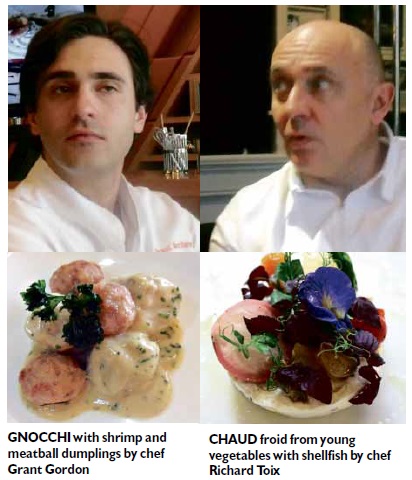So, adobo has been proposed as the national dish. But for the information of our legislators, and especially the one who filed the bill, adobo is not a dish. Adobo is a way of cooking. That’s why we have different kinds of adobo—chicken, pork, beef, all meats together, kangkong, pata, hito, alimango, and so on. Now which of those should be regarded as the national dish?
Congress should really concentrate on more important laws to be passed instead of wasting time on silly proposals.
The better story is how Manila played host to three visiting chefs last week.
Michelin-star chef Richard Toix left his restaurant Passions et Gourmandises in Saint-Benoit, France, for a while to cook at the Tivoli of the Mandarin Oriental Manila. His menu at his restaurant caught my attention because it had a dish that said “Illusion of foie gras.”
Toix does create an illusion of complexity with his dish presentation, but what is important to him is that the “composition and taste” should be natural. A colorful salad-like appetizer reveals a chaud froid (gelatin) bed, then shellfish underneath all those vegetables, tomatoes and edible flowers.
Thin potato strips (croustillant) form a rounded wall over a foamy brown butter mixture flavored with truffles. Soup was chestnut with a cream foam on top. A course on the degustation menu merely said “mushrooms,” but the seeming simplicity included thin slices of button mushrooms hiding bacon ice cream.
The main course was medium rare lamb loin encrusted with crushed nori seaweeds with a lemon paste to flavor it and a tangle of vegetable salad beside it. Toix intriguingly named his dessert Black Forest 2014, which appeared as a red disc with the mousse underneath. All of these were taken with a wine degustation, going from a French sauvignon blanc to an albariño from Spain, a voignier from France, pinot noir from the US, then a porto from Portugal.
Richard Toix said that he likes to cook what is in season. Spring is near, he said, and so there will be truffles, scallops, green asparagus, langoustines and artichokes at Saint-Benoit.
He went to Farmer’s Market in Quezon City to see the local ingredients and remembers beef tapa, longganisa, sayote, kangkong and ubod.
But what he loved was mango with bagoong (shrimp paste) and he is thinking of incorporating bagoong in one of his dishes. The way his eyes lit up when saying that, you’d think he’s Filipino.
Another chef, American Grant Gordon, cooked at the Diamond Hotel’s Pisces Culinary Studio on the 27th floor. His visit is part of the US Embassy’s Culinary Diplomacy Program involving offices of the Department of Agriculture, Public Affairs and the Foreign Agricultural Service.
James Beard nominee
Gordon, a James Beard award nominee for the “rising Star Chef of the Year,” had just resigned as executive chef of Tony’s in Houston before his trip here. He said he is opening his own restaurant in Houston.
He gave a demo of two of his courses for lunch. One was the gnocchi, potato dumplings, partnered with meatballs of shrimp and pancetta flavored with a Pernod sauce, an anise liqueur.
The other was saffron shellfish veloute served as soup, the broth involving mussels which the chef said was discarded after the flavor was extracted (to the surprise of the kitchen staff).
Unsurprising was the use of USDA Prime Strip but done perfectly with a wine reduction sauce poured after the dish was served.
Gordon said he doesn’t do desserts and so the Diamond kitchen presented a chocolate banana pie.
Beringer and Happy Living wines accompanied each course, with the Beringer Cabernet Sauvignon 2011 Napa Valley, rounded and rich, as the most memorable.
Like Toix, Gordon went to Farmer’s Market to get an idea of ingredients here, and it was the crablets that he remembered.
He also had a luncheon at Claude and Mary Ann Tayags’ Bale Dutung in Angeles, Pampanga, a good introduction to just one of our cuisines.
And he enjoyed eating out at a Chinese restaurant with the family of chef See Cheong Yan, culinary head of Enderun Colleges, also because he and chef See have similar professional experiences.
And then another French culinary figure arrived to formally open his first shop in Manila.
Baker
Eric Kayser, whose “Artisan Boulanger” is named after him, cut the ribbon at the Market Place supermarket in Rockwell Power Plant Mall in Makati, the first one in the country.
He has 96 bake shops in 17 countries, all retaining traditional baking practices such as slow kneading and long natural fermentation.
No commercial yeast is used, he said, but a natural liquid leaven, a crumbly mixture that he showed us.
Pastry chef and bread-making instructor Jill Sandique explained to me many of the unfamiliar processes that Kayser was telling his audience.
Having gone throughout the country researching on traditional bakeries, breads and biscuits with two writers (Amy Uy and Jenny Orillos), photographer (Pie David) and with Sandique doing the home baking recipes for the “Panaderia” book, it was fun to identify which of our breads were similar to French breads—at least in shape like the star bread, Spanish bread, bonete and monay.
While he signed his book, I approached Kayser and made him sample the marcasotes I brought from Camalig in Bicol, a bread steamed in a brown paper bag. Quite a different kind of bread, he declared it to be.
This March, three more chefs will be visiting. One is Alain Ducasse, who has multi-star restaurants in different countries; Yannick Van Aeken, former sous chef of the famed Noma Restaurant in Copenhagen; and Louise Bannon, pastry chef of Noma. They will be guests of chef Roby Goco of Green Pastures and Cyma.
E-mail the author at pinoyfood04@yahoo.com.
